The post Precast building using conductive concrete for shielding sensitive installations first appeared on Sindh Courier.
]]>Abu Dhabi
A research team from American University of Sharjah (AUS) and the Sharjah Research Technology and Innovation (SRTIP) are set to throw open the doors of the precast building made of conductive concrete used for shielding, a fruit of 16 years of extensive exploration and testing.
Located at the SRTIP, the innovative building uses a concrete mix that provides protection from electromagnetic pulses (EMP), otherwise known as electronic sabotage, for the protection of vital civilian and military infrastructure. Two patents have already been filed with the United States Patent and Trademark Office for the technology.
The path-breaking innovation is the brainchild of two lead researchers, Dr. Sherif Yehia from the AUS Department of Civil Engineering and Dr. Nasser Qaddoumi from the AUS Department of Electrical Engineering, who first met in 2009. Together they collaborated and explored the diverse applications of conductive concrete, which initially focused on heating applications and then expanded to investigate the shielding features of conductive concrete.
“Conductive concrete has been used for a variety of applications around the world, but this is the first precast building of its kind that uses this technology for shielding,” said Dr. Yehia.
He added, “This means that the building is impervious to energy pulses, preventing the risk of short-cutting electronic equipment. The structure ensures a complete signal blockade, preventing any external signals from entering or leaving. This innovative technology holds the potential to safeguard critical facilities like data centers, power stations and security centers.”
Their joint project earned the researchers university and industry recognition, securing backing for their research which was carried out in the College of Engineering’s state-of-the-art labs.
“We received tremendous support from AUS and its Office of Research and Graduate Studies through several faculty research grants and aid in the process of filing for the US patent,” said Dr. Qaddoumi. “We also got generous support from Hussain Al Mahmoudi, CEO of SRTI Park, who offered us funding, land for construction and helped us form an advisory board for the project. ALEC Engineering Contracting, currently overseeing the building construction, played a pivotal role in its development.”
Throughout the process, both researchers acknowledged the contributions of their students at the undergraduate and graduate level in assisting them in their work, whether through conducting research, taking measurements, assisting in prototype development, or even in initiating their own research in areas related to the work carried out by the two researchers. This gave students valuable, hands-on experience throughout the implementation of the project.
Going forward, the researchers will be exploring collaboration avenues with industry partners to extend the scope of their work for wider application. One of the main outcomes of the project is the creation of novel concrete materials that will help the growth of the construction industry and contribute to EMP (electromagnetic pulses) protection of the electric grids, generators, and buildings with sensitive equipment and information. In addition, collaboration with precast and ready-mix producers will ensure transfer of knowledge to the construction industry.
The key advantages of conductive concrete are: shielding against EMP without the need for any special additions, improved mechanical properties, relatively lower costs compared to other shielding techniques and ability to be produced as precast units.
Published under the International Cooperation Protocol with Middle East Business
__________________
The post Precast building using conductive concrete for shielding sensitive installations first appeared on Sindh Courier.
]]>The post UAE launches ‘We the UAE for Strategic Intelligence 2031’ platform with World Economic Forum first appeared on Sindh Courier.
]]>Abu Dhabi
The UAE Government and the World Economic Forum (WEF) have signed a partnership agreement to develop the “We the UAE for Strategic Intelligence 2031” platform, which represents a digital model powered by artificial intelligence, incorporating the best global knowledge resources and international experts in various sectors.
The platform aims to support policymakers, strategists, and government leaders in the UAE with a specialized strategic knowledge base in priority sectors outlined in the “We the UAE 2031” vision.
The agreement was signed during the World Economic Forum 2024, in the presence of Mohammad bin Abdullah Al Gergawi, Minister of Cabinet Affairs, and Professor Klaus Schwab, Founder and Executive Chairman of the World Economic Forum.
Also read: ‘UAE Warriors’ launches new season on January 20 in International and Arabia series
Huda Al Hashimi, Deputy Minister of Cabinet Affairs for Strategic Affairs and Stephan Mergenthaler, Head of Strategic Intelligence, World Economic Forum, have signed the agreement.
Al Hashimi affirmed that enhancing the government’s flexibility, its readiness for the future, and developing proactive strategies are main pillars of the UAE’s directions.
She added that launching the initiative reflects the advanced level of the strategic relationship between the UAE government and the World Economic Forum. “The UAE aspires to become a global hub of excellence in foresight and strategic thinking,” she noted.
Also read: UAE hosts Advanced Unmanned Technology Exhibition
Al Hashimi further added that the platform will support policymakers and governmental strategies in achieving the vision of “We the UAE 2031”. It provides a national and global strategic network comprising elite leaders and experts aimed at finding solutions, capitalizing on opportunities, exchanging the best practices, and transferring knowledge, skills and expertise.
Professor Klaus Schwab said, “We face a fractured world and growing societal divides, leading to pervasive uncertainty and pessimism. We have to rebuild trust in our future by moving beyond crisis management, looking at the root causes of the present problems, and building together a more promising future. Trust and cooperation are a must in a connected, yet divided world.”
The Founder and Executive Chairman of WEF added, “From empowering food innovation and unlocking trade technologies, to harnessing the full power of technology to improve government services, the World Economic Forum is proud of its many forward-looking collaborations with the United Arab Emirates, which are tackling global challenges from a unique, multi-stakeholder perspective.”
Also read: Sindh’s Karachi Port Leased Out To UAE Companies
The platform represents a meaningful initiative to uphold the targets outlined in the vision “We the UAE 2031”. It involves the development of a new model for strategic design, powered by artificial intelligence, utilizing specialized global resources, and harnessing data and information provided by over 2500 international experts and more than 450 global sources.
The platform is empowered by artificial intelligence technology tools to provide swift and accurate analyses. This includes summaries of the latest research, studies, and possible scenarios related to each topic, as well as key strategic trends and practices. The platform will provide interactive multidimensional analytical maps for decision-makers, policymakers, and government strategists.
Published under the International Cooperation Protocol with Middle East Business
______________________
The post UAE launches ‘We the UAE for Strategic Intelligence 2031’ platform with World Economic Forum first appeared on Sindh Courier.
]]>The post UAE hosts Advanced Unmanned Technology Exhibition first appeared on Sindh Courier.
]]>Abu Dhabi
EDGE is making its third appearance at the Unmanned Systems Exhibition and Conference (UMEX) and Simulation and Training Exhibition (SimTEX) 2024, reinforcing its position as one of the world’s leading advanced technology groups in the unmanned and autonomous systems sector.
Returning as the exhibition’s official Strategic Partner, EDGE will highlight its goal of significantly accelerating UAE-manufactured advanced technology and autonomous capabilities with a showcase of industry-leading unmanned technologies and solutions, including autonomous unmanned aerial vehicles (UAVs) and unmanned ground vehicles (UGVs).
Mansour Al Mulla, Managing Director and CEO of EDGE Group, said, “UMEX presents EDGE with the perfect opportunity to demonstrate the rapid growth of our portfolio of advanced unmanned and autonomous technology systems, while highlighting our vision of adopting advanced technologies to accelerate and reinforce our sovereign capabilities. We are fully dedicated to playing a pivotal role as a growing industry leader in this domain. UMEX 2024 will also highlight the swift progress that EDGE has made in expanding our global footprint, forging valuable partnerships, and developing the latest solutions and services in the field of autonomous air, land, and sea systems, solutions, and services.”
Under autonomous systems, EDGE will display a range of autonomous unmanned jet-powered and electric-powered aircraft, including fixed-wing loitering munitions, a stealth aircraft, a large fixed-wing intelligence, surveillance, target acquisition, and reconnaissance (ISTAR) aircraft, a multi-role performance helicopter, and tactical logistics helicopters.
Under land systems, EDGE will display autonomous ground vehicles, including mission-proven tracked UGVs, a rapidly deployable armed robotic vehicle, and small UGVs.
The event will also mark the first time that ETIMAD, a technology solutions and Services Company with a focus on security systems solutions, systems integration, project fulfilment, and execution in the fields of border and civil security, is participating at UMEX as part of EDGE Group.
Attendees of UMEX and SimTEX 2024 can visit EDGE and its portfolio of companies in Hall 5, Stand A18 at the Abu Dhabi National Exhibition Centre (ADNEC) from 23rd to 25th January.
Published under International Cooperation Protocol with Middle East Business | Life Magazine
____________________
The post UAE hosts Advanced Unmanned Technology Exhibition first appeared on Sindh Courier.
]]>The post Research and Production: Pakistan lagging behind developed countries first appeared on Sindh Courier.
]]>From Correspondent
Tandojam, Sindh
Dr. SM Tariq Rafi, Chairman, Sindh Higher Education Commission (SHEC) Karachi said on Monday that in the field of production and research, Pakistan is lagging behind developed countries in terms of results.
“However, our institutions are doing satisfactory achievements, and are supporting the students in their ideas and startups,” he said speaking at the first two-day International Humanitarian Technology Conference 2024, held under the auspices of the Information Technology Center of Sindh Agriculture University (SAU), Tandojam, in collaboration with the Institute of Electrical and Electronics Engineers (IEEE) Karachi Section.
The national and international experts in their address said that revolutionary changes have taken place in the world with technology. They emphasized that in the future agricultural Research support programs should be promoted to achieve the required results of development.
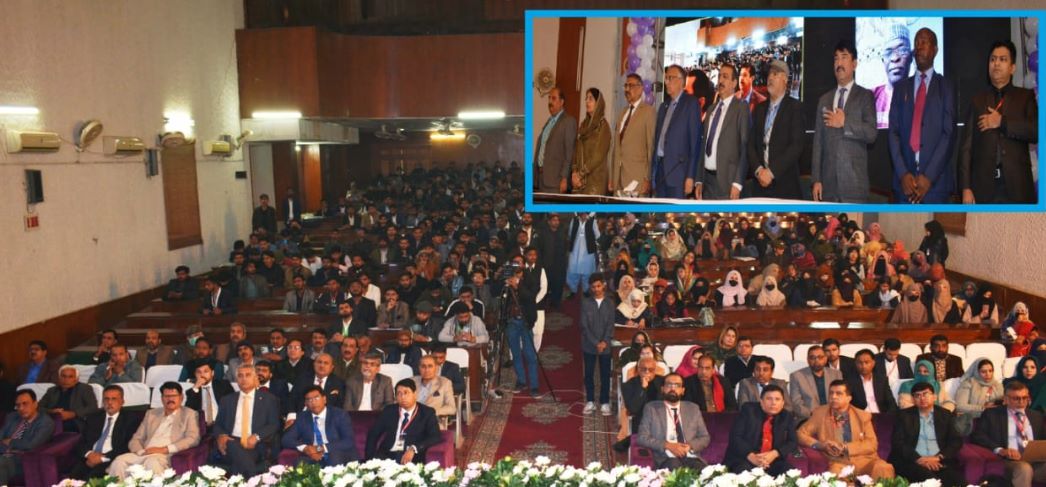 Prof. Dr. Asadullah Shah of University of International Islamic University Malaysia said that technology has gained importance in human life with achievements and innovations, while Open AI chat GPT has revolutionized human society, which is capable of answering many questions.
Prof. Dr. Asadullah Shah of University of International Islamic University Malaysia said that technology has gained importance in human life with achievements and innovations, while Open AI chat GPT has revolutionized human society, which is capable of answering many questions.
SAU Vice Chancellor Dr. Fateh Marri, Prof. Dr. Bhawani Shankar Chowdhry, Chair, IEEE Karachi Section and National Professor, Dean of Faculty of Agricultural Social Sciences Dr. Aijaz Ali Khooharo, Director ITC Dr. Mir Sajjad Talpur, Dr. Muhammad Yaqoob Koondhar also spoke on this occasion.
Vice Chancellor of Shah Abdul Latif University Khairpur Dr. Khalil Ahmed Ibupoto, Vice Chancellor of Sufi University Bhit Shah Dr. Parveen Munshi, Pro Vice Chancellor Sub Campus Umerkot Dr. Jan Muhammad Marri, Dr. Falak Musa from Kenya, Prof. Aznan from Malaysia, Dr. Azhar Ali Shah, and the experts from University of Sindh, Mehran University Jamshoro, IBA Sukkur, NED University, Karachi University, IOBM Karachi, Shah Abdul Latif University Khairpur also participated. Later, the experts presented their papers in technical session.
_______________
The post Research and Production: Pakistan lagging behind developed countries first appeared on Sindh Courier.
]]>The post The World of Artificial Intelligence and the Future of Lawyers first appeared on Sindh Courier.
]]>Bukhari Zulfiqar Shah
The new generation of AI is likely to make many things possible that we previously regarded as impossible. As Napoleon Bonaparte once said, “Impossible is a word to be found only in the dictionary of fools.”
According to the conventional wisdom, regular labor in offices and factories, such as bookkeeping or running simple machinery, is most susceptible to automation. But so-called natural language processing, an AI capability that can read and interpret text or voice, is displacing experts’ jobs. For instance, a significant amount of legal labor is routine. However, language has shielded lawyers from the consequences of automation in this everyday labor of searching through papers for pertinent information, but not anymore.
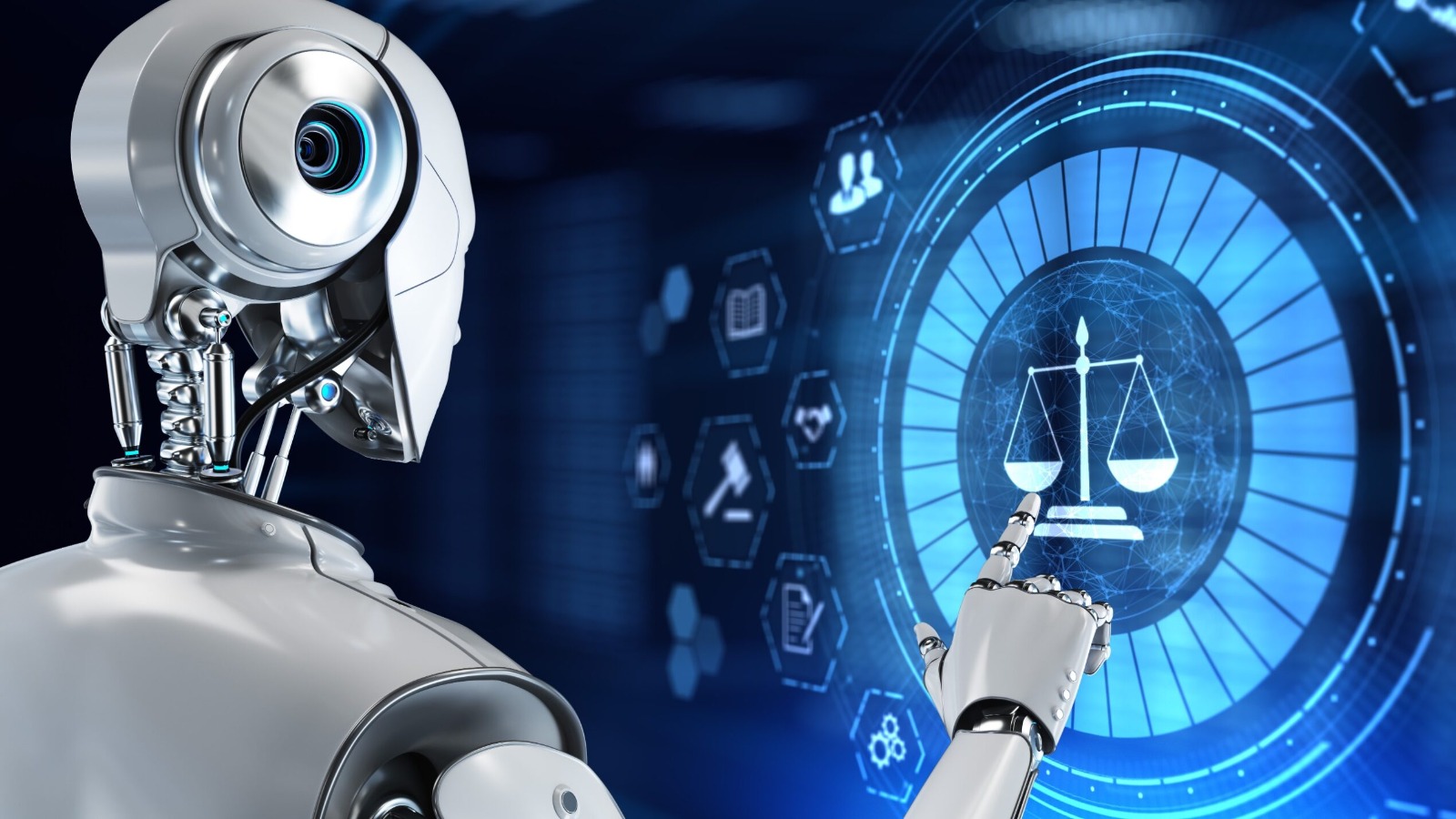 The legal sector is increasingly adopting artificial intelligence (AI) for many purposes. The use of AI across the legal sector, but especially by in-house lawyers, is poised to usher in a revolution in the legal profession. Similar to how email revolutionized business as usual, AI will spread like wildfire and become every lawyer’s necessary helper. But what role will AI play in the legal sector in the future? A more important concern is if artificial intelligence will really replace lawyers as implied above. And if so, are there any moral or ethical quandaries that should be taken into account when it comes to AI and the legal sector? Several things may be said about the industry’s use of AI in the future: First, those who resist the change and do not accept it will be left behind in some way. Secondly, those who do use AI will find themselves eventually freed up to do the two things for which there is always too little time: thinking and advising. The second essay in a four-part series on artificial intelligence (AI) examines whether or not lawyers need to be concerned about being replaced by the technology.
The legal sector is increasingly adopting artificial intelligence (AI) for many purposes. The use of AI across the legal sector, but especially by in-house lawyers, is poised to usher in a revolution in the legal profession. Similar to how email revolutionized business as usual, AI will spread like wildfire and become every lawyer’s necessary helper. But what role will AI play in the legal sector in the future? A more important concern is if artificial intelligence will really replace lawyers as implied above. And if so, are there any moral or ethical quandaries that should be taken into account when it comes to AI and the legal sector? Several things may be said about the industry’s use of AI in the future: First, those who resist the change and do not accept it will be left behind in some way. Secondly, those who do use AI will find themselves eventually freed up to do the two things for which there is always too little time: thinking and advising. The second essay in a four-part series on artificial intelligence (AI) examines whether or not lawyers need to be concerned about being replaced by the technology.
Certain aspects of a lawyer’s profession, such document inspection, legal research, and contract analysis, could one day be replaced by AI. It added its view that “it is unlikely that AI will completely replace the role of lawyers as the legal profession requires a high degree of critical thinking, problem-solving, and decision-making skills that are currently difficult for AI to replicate,” maybe in an effort to make us feel better. it is more likely that AI will become a tool that lawyers use to augment their abilities, rather than a replacement for lawyers altogether.
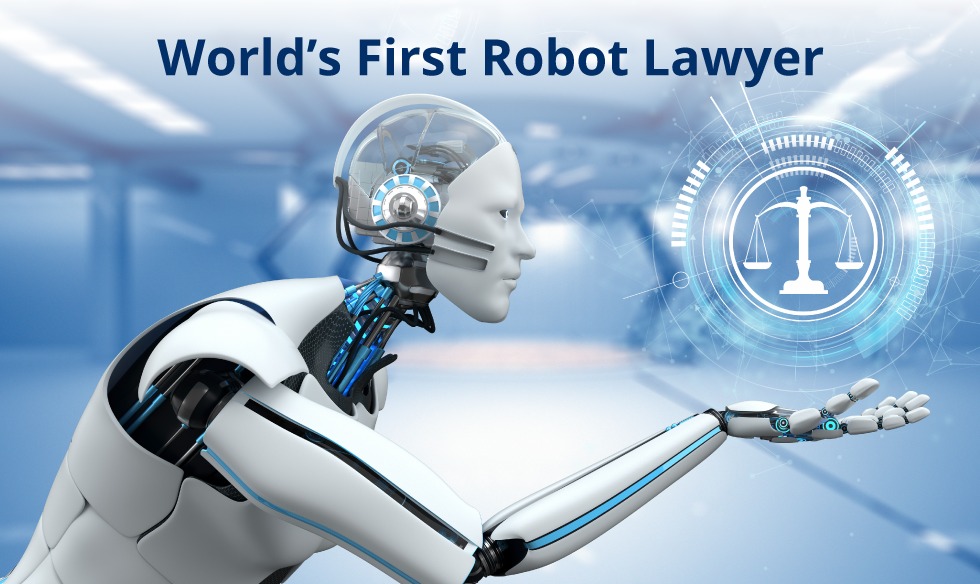 However, AI is not yet ready to replace human judgment in the legal profession. The risk of embedded bias in data that fuels AI and the inability to adequately understand the rationale behind AI-derived decisions in a way understandable to humans (i.e., explainability) must be overcome before using the technology in some legal contexts.
However, AI is not yet ready to replace human judgment in the legal profession. The risk of embedded bias in data that fuels AI and the inability to adequately understand the rationale behind AI-derived decisions in a way understandable to humans (i.e., explainability) must be overcome before using the technology in some legal contexts.
Researching the law is another area where AI is already widely employed in legal practice
The inevitable evolution of artificial intelligence means that lawyers will need to keep up with the latest developments and learn how to use AI to their advantage.
Lawyers can use AI in practice as it can free up time to focus on other, more human-centric tasks, such as client meetings and trial preparation. It can assist in legal research by quickly searching through large amounts of data to find relevant information. This can save lawyers time through more efficient research. AI also can be used to create legal documents such as contracts and pleadings. This can be helpful for lawyers who do not have the time to draft these documents themselves. Standard administrative tasks such as scheduling appointments and managing law firm finances can be time-consuming and can prevent lawyers from focusing on more important tasks in their practice.
Researching the law is another area where AI is already widely employed in legal practice. Since AI has been effortlessly incorporated into many research services, practicing lawyers might not even be aware that they are using it in this field. Westlaw Edge is one such service that was introduced by Thomson Reuters more than three years ago. Semantic search has been added to the keyword or boolean search strategy that was the service’s defining feature for decades. This indicates that rather than just matching words to keywords, the machine learning algorithms are attempting to comprehend the meaning of the phrases. Quick Check, another AI-powered function from Westlaw Edge, analyzes a draft argument to uncover new information or locate pertinent authority that may have been overlooked. Even cases that have been indirectly reversed can be found with Quick Check.
AI’s usage in advising courts on bail and sentencing decisions is more worrisome
Predicting legal outcomes is another innovative application of AI. Understanding the chances of a case succeeding might be quite beneficial. It enables a lawyer to make decisions regarding taking a case on contingency, the amount to spend on experts, and whether to advise their clients to settle. Businesses like Lex Machina employ machine learning and predictive analytics to make predictions about the behaviors and outcomes of judges, lawyers, and the case itself.
AI’s usage in advising courts on bail and sentencing decisions is more worrisome. Correctional Offender Management Profiling for Alternative Sanctions (COMPAS) is one such application. Criminal courts in numerous states employ COMPAS and similar AI techniques to determine whether to sentence, detain, or release a defendant early based on the likelihood that they will reoffend. The fairness or accuracy of these methods are hotly contested topics. A ProPublica research found that these assessment systems appeared to be biased against black inmates, classifying them as being markedly more likely to commit crimes again than white inmates. The business that created COMPAS, Equivant, attempted to disprove the ProPublica investigation and dismissed its findings regarding racial bias.
Smartphones can be used in China to lodge complaints, monitor the status of cases, and get in touch with judges. In so-called “one-stop” stations, AI-based automated devices are available around-the-clock to register cases, generate legal papers, and provide legal consultations. Even legal fees can be calculated by them. However, the accuracy of the data produced by these automated lawyers is up for question. According to reports, the robots take into account the financial, emotional, and time costs associated with situations and give customers calculated information on prognosticating outcomes.
In December 2019, China has announced that millions of legal cases are now being decided by “Internet courts” that do not require citizens to appear in court. The “smart court” includes non-human judges, powered by artificial intelligence (AI) and allows participants to register their cases online and resolve their matters via a digital court hearing. China’s first Internet court was established in the eastern city of Hangzhou in 2017 and in 2019, it was reported that users completed more than 3.1 million legal activities using the court system from March through to October. More than one million citizens were registered with the system, along with approximately 73,000 lawyers.
 Since 2014, UNESCO and its partners have been training judges and judicial actors on freedom of expression, public access to information and safety of journalists, mainly through Massive Open Online Courses (MOOC). More than 17,000 judicial actors have been trained in Latin America, in partnership with the Inter-American Court of Human Rights, as well as in Africa, where UNESCO has partnered with the Center for Human Rights of the University of Pretoria, the African Commission on Human and Peoples’ Rights, the African Court on Human and Peoples’ Rights and the Economic Community of West African States. Considering rapid developments in this field, the challenges and opportunities related to harnessing AI in judicial systems and their implications for human rights and the rule of law must form part of discussions among stakeholders from the judicial ecosystem. The online training course in the form of a Massive Online Open Course (MOOC) is being developed in cooperation with UNESCO’s category 2 center CETIC and the IEEE in response to the needs expressed by UNESCO Member States, judges and other stakeholders. The (MOOC) on AI and the Rule of Law is an introductory course engaging judicial operators in a global and timely discussion around AI’s application and impact on the rule of law.
Since 2014, UNESCO and its partners have been training judges and judicial actors on freedom of expression, public access to information and safety of journalists, mainly through Massive Open Online Courses (MOOC). More than 17,000 judicial actors have been trained in Latin America, in partnership with the Inter-American Court of Human Rights, as well as in Africa, where UNESCO has partnered with the Center for Human Rights of the University of Pretoria, the African Commission on Human and Peoples’ Rights, the African Court on Human and Peoples’ Rights and the Economic Community of West African States. Considering rapid developments in this field, the challenges and opportunities related to harnessing AI in judicial systems and their implications for human rights and the rule of law must form part of discussions among stakeholders from the judicial ecosystem. The online training course in the form of a Massive Online Open Course (MOOC) is being developed in cooperation with UNESCO’s category 2 center CETIC and the IEEE in response to the needs expressed by UNESCO Member States, judges and other stakeholders. The (MOOC) on AI and the Rule of Law is an introductory course engaging judicial operators in a global and timely discussion around AI’s application and impact on the rule of law.
In short, AI continues to evolve, lawyers must keep up with the latest developments to ensure they use it to the fullest of their abilities. They should be committed to learning about new AI applications and how they can be used in their practice. AI is already changing the legal profession, and it is almost certain to have a big impact in the future. Lawyers should stay up to date on AI developments, learn how to use AI applications in their practice, and always be ready to adapt to the evolution of this helpful tech. As a way to make the process of law faster and more free from errors or omissions, AI is a welcome tool in the cause of justice. AI may be a more efficient way to resolve civil cases, while at the same time increasing predictability without creating a moral hazard. When AI is utilized in place of human judgment, particularly in the context of criminal law, it becomes increasingly problematic. For a variety of reasons, AI is not prepared for this. One is that there might be bias in the training data, which the resulting machine learning (ML) models will amplify and further institutionalize. We might be able to solve this issue; in fact, eliminating bias from our training data may help us recognize and address some of the inherent sexism and racism in our judicial system.
__________________
About the Author
 Bukhari Zulfiqar Shah, hailing from Khairpur Mirs, an advocate of Sindh High Court, is currently doing Ph.D. in International Environmental Law from Xian Jiaotong University, China. He did B. Commerce, LLB, MA Journalism, and MA Sociology from Shah Abdul Latif University Khairpur, and did LLM from Zhejiang University, China. He served more than 15 years in development sector at deferent levels along with banking and government sectors in Pakistan. Email: advbukhari@gmail.com
Bukhari Zulfiqar Shah, hailing from Khairpur Mirs, an advocate of Sindh High Court, is currently doing Ph.D. in International Environmental Law from Xian Jiaotong University, China. He did B. Commerce, LLB, MA Journalism, and MA Sociology from Shah Abdul Latif University Khairpur, and did LLM from Zhejiang University, China. He served more than 15 years in development sector at deferent levels along with banking and government sectors in Pakistan. Email: advbukhari@gmail.com
The post The World of Artificial Intelligence and the Future of Lawyers first appeared on Sindh Courier.
]]>The post Murad for using Sci. & Tech to alleviate poverty first appeared on Sindh Courier.
]]>Karachi
Sindh Chief Minister Syed Murad Ali Shah has said that science and technology can be effectively used to solve problems of poverty, food insecurity, and climate change, in the Muslim world.
This he said while speaking at the Inaugural Ceremony of ‘The 24th Scientific Conference of Islamic World Academy of Sciences On ‘Challenges to Promote Science & Technology for Socio-Economic Development in OIC Countries’ organized by the University of Karachi on Tuesday.
The conference was attended by the President of The World Academy of Sciences Prof. Dr. Adnan Badran, Prof. Dr. Atta-ur-Rahman, Coordinator General COMSTECH Prof. Dr. Muhammad Iqbal Choudhry, Vice Chancellor Karachi University & Patron-in-Chief of International Center for Chemical and Biological Sciences (ICCBS) Prof. Dr. Khalid Mahmood Iraqi, Chairman Hussein Ebrahim Jamal Foundation Aziz Latif Jamal, Chairperson Dr. Panjwani Memorial Trust Ms. Nadira Panjwani and Foreign and Local Delegates.
Shah said, “It is only through the applications of science and technology that we can handle the enduring challenges of poverty, climate change, food insecurity, and increasing disease burdens, that world faces today.”
He said ‘we needed to not only solve many local issues, but also partner with other nations in handling global challenges.’
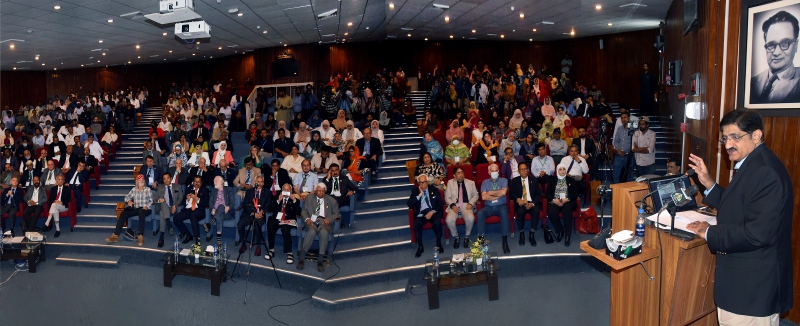 CM said that his government has placed the ICCBS at the center of its science and technology-based initiatives. “Various departments of my government are working closely with the ICCBS management to establish research centers, upgrade the existing laboratory infrastructure of the province, as well to conduct some of the enduring issues in health and agriculture that the province is facing today,” he said and added the establishment of the Sindh Serology and DNA Forensic lab, the upgrading of the Chemico-bacterial lab in Karachi, and the establishment of the Traditional Medicine Research Center were the institutions where ICCBS was supporting the provincial government.
CM said that his government has placed the ICCBS at the center of its science and technology-based initiatives. “Various departments of my government are working closely with the ICCBS management to establish research centers, upgrade the existing laboratory infrastructure of the province, as well to conduct some of the enduring issues in health and agriculture that the province is facing today,” he said and added the establishment of the Sindh Serology and DNA Forensic lab, the upgrading of the Chemico-bacterial lab in Karachi, and the establishment of the Traditional Medicine Research Center were the institutions where ICCBS was supporting the provincial government.
Shah said that he was delighted to know that his idea of the establishment of a seamless learning platform for the universities has been implemented as the SIREN (Sindh Innovation, Research, and Education Network) by the ICCBS which connects leading universities of Sindh.
“My government has also decided to declare five centers of the ICCBS as Sindh Health Care Research facilities in fields such as regenerative medicine, disease genomics, and pharmaceutical research,” he said.
Talking to the media the CM said that his government has enhanced the annual grant of the public sector universities by three times. “But the public-private partnership initiative of his government has produced the best results in education and health sectors,” he said.
To a question, Shah said that the NICVD was performing well. “Yes, there are some issues of foreign exchange, therefore some equipment/gadgets might have not been procured but those issues would be resolved,” he said.
To another question, the CM said that the director of finance would be appointed in all government universities and institutions for which the method was being evolved. (PR)
_____________
The post Murad for using Sci. & Tech to alleviate poverty first appeared on Sindh Courier.
]]>The post Artificial Intelligence could spot alien signals humans miss first appeared on Sindh Courier.
]]>Alexandra Witze
From the hills of West Virginia to the flats of rural Australia, some of the world’s largest telescopes are listening for signals from distant alien civilizations. The search for extraterrestrial intelligence, known as SETI, is an effort to find artificial-looking electromagnetic-radiation signals that might have come from a technologically advanced civilization in a far-away solar system. A study published today1 describes one of several efforts to use machine learning, a subset of artificial intelligence (AI), to help astronomers sift quickly through the reams of data such surveys yield. As AI reshapes many scientific fields, what promise does it hold for the search for life beyond Earth?
“It is a new era for SETI research that is opening up thanks to machine-learning technology,” says Franck Marchis, a planetary astronomer at the SETI Institute in Mountain View, California.
The problem of big data is relatively new for SETI. For decades, the field was constrained by having hardly any data at all. Astronomer Frank Drake pioneered SETI in 1960, when he pointed a telescope in Green Bank, West Virginia, towards two stars and listened for radio transmissions. Most of the SETI searches that followed were also limited to a small number of stars.
But in 2015, billionaire Yuri Milner funded the biggest SETI program ever, in Berkeley, California: the Breakthrough Listen project to search one million stars for signs of intelligent life. Using telescopes in West Virginia, Australia and South Africa, the project looks for radio emissions that come from the direction of a star and that change steadily in frequency, as would happen if an alien transmitter were on a planet moving with respect to Earth.
Data blizzard
The trouble is that these searches yield a blizzard of data — including false positives produced by Earthly interference from mobile phones, GPS and other aspects of modern life.
“The biggest challenge for us in looking for SETI signals is not at this point getting the data,” says Sofia Sheikh, an astronomer at the SETI Institute. “The difficult part is differentiating signals from human or Earth technology from the kind of signals we’d be looking for from technology somewhere else out in the Galaxy.”

Going through millions of observations manually isn’t practical. A common alternative approach is to use algorithms that look for signals matching what astronomers think alien beacons could look like. But those algorithms can overlook potentially interesting signals that are slightly different from what astronomers are expecting.
Enter machine learning. Machine-learning algorithms are trained on large amounts of data and can learn to recognize features that are characteristic of Earthly interference, making them very good at filtering out the noise.
Overlooked signals
Machine learning is also good at picking up candidate extraterrestrial signals that don’t fall into conventional categories and so might have been missed by earlier methods, says Dan Werthimer, a SETI scientist at the University of California, Berkeley.
Peter Ma, a mathematician and physicist at the University of Toronto, Canada, and lead author of today’s paper, agrees. “We can’t always be anticipating what ET might send to us,” he says.
Ma and his colleagues sifted through Breakthrough Listen observations of 820 stars, made using the 100-metre Robert C. Byrd Green Bank Telescope. They built machine-learning software to analyze the data; this netted nearly three million signals of interest but discarded most as Earth-based interference. Ma then manually reviewed more than 20,000 signals and narrowed them down to 8 intriguing candidates.
The search ultimately came up empty — all eight signals disappeared when the team listened again. But the methods could be used on other data, such as a flood of observations from the MeerKAT array of 64 radio telescopes in South Africa, which Breakthrough Listen began using in December. The machine-learning algorithms could also be used on archived SETI data, says Ma, to seek signals that might previously have been overlooked.
Citizen SETI
Machine learning is also at the heart of a separate SETI effort that will launch next month. On 14 February, astronomers at the University of California, Los Angeles (UCLA), will launch a community-science project in which volunteers from the public will sort through images of radio signals and classify them as potential types of interference, to train a machine-learning algorithm to search SETI data from Green Bank.
And AI can help with other stages of the SETI process. Werthimer and his colleagues have used machine learning to come up with a ranking of stars to be observed in an ongoing SETI project that uses the world’s largest single-dish telescope, the 500-metre FAST radio telescope in China.
Still, SETI will probably continue to use a mixture of classical and machine-learning approaches to sort through data, says Jean-Luc Margot, an astronomer at UCLA. Classical algorithms remain excellent at picking up candidate signals, and machine learning is “not a panacea”, he says.
___________________
Courtesy: Nature (Posted on Jan 30, 2023)
The post Artificial Intelligence could spot alien signals humans miss first appeared on Sindh Courier.
]]>The post Liquid-metal robots can melt and re-form first appeared on Sindh Courier.
]]>By Karmela Padavic-Callaghan
A miniature, shape-shifting robot can liquefy itself and reform, allowing it to complete tasks in hard-to-access places and even escape cages. It could eventually be used as a hands-free soldering machine or a tool for extracting swallowed toxic items.
Robots that are soft and malleable enough to work in narrow, delicate spaces like those in the human body already exist, but they can’t make themselves sturdier and stronger when under pressure or when they must carry something heavier than themselves. Carmel Majidi at Carnegie Mellon University in Pennsylvania and his colleagues created a robot that can not only shape-shift but also become stronger or weaker by alternating between being a liquid and a solid.
They made the millimeter-sized robot from a mix of the liquid metal gallium and microscopic pieces of a magnetic material made of neodymium, iron and boron. When solid, the material was strong enough to support an object 30 times its own mass. To make it soften, stretch, move or melt into a crawling puddle as needed for different tasks, the researchers put it near magnets. The magnets’ customized magnetic fields exerted forces on the tiny magnetic pieces in the robot, moving them and deforming the surrounding metal in different directions.
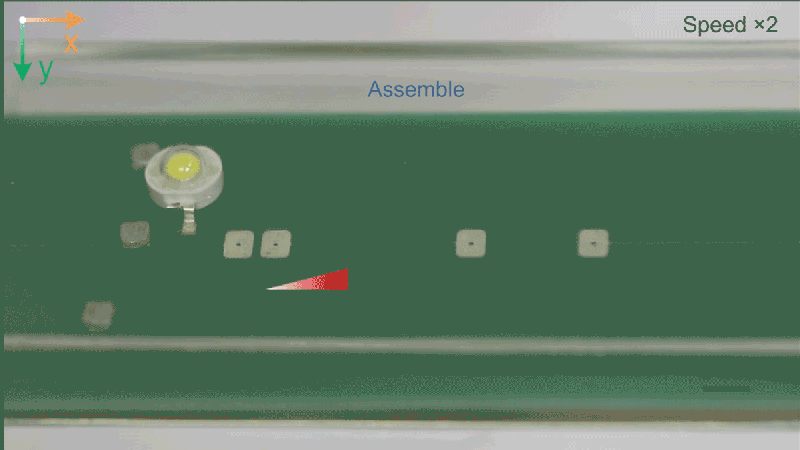 For instance, the team stretched a robot by applying a magnetic field that pulled these granules in multiple directions. The researchers also used a stronger field to yank the particles upwards, making the robot jump. When Majidi and his colleagues used an alternating magnetic field – one whose shape changes predictably over time – electrons in the robot’s liquid metal formed electric currents. The coursing of these currents through the robot’s body heated it up and eventually made it melt.
For instance, the team stretched a robot by applying a magnetic field that pulled these granules in multiple directions. The researchers also used a stronger field to yank the particles upwards, making the robot jump. When Majidi and his colleagues used an alternating magnetic field – one whose shape changes predictably over time – electrons in the robot’s liquid metal formed electric currents. The coursing of these currents through the robot’s body heated it up and eventually made it melt.
“No other material I know of is this good at changing its stiffness this much,” says Majidi.
Exploiting this flexibility, the team made two robots carry and solder a small light bulb onto a circuit board. When they reached their target, the robots simply melted over the light bulb’s edges to fuse it to the board. Electricity could then run through their liquid metal bodies and light the light bulb.
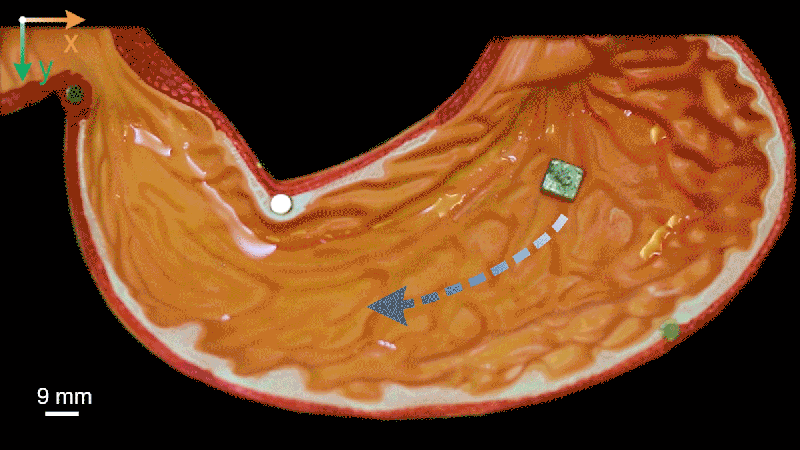 In an experiment inside an artificial stomach, the researchers applied another set of magnetic fields to make the robot approach an object, melt over it and drag it out. Finally, they shaped the robot like a Lego minifigure, then helped it escape from a cage by liquefying it and making it flow out between the bars. Once the robot puddle dribbled into a mould, it set back into its original, solid shape.
In an experiment inside an artificial stomach, the researchers applied another set of magnetic fields to make the robot approach an object, melt over it and drag it out. Finally, they shaped the robot like a Lego minifigure, then helped it escape from a cage by liquefying it and making it flow out between the bars. Once the robot puddle dribbled into a mould, it set back into its original, solid shape.
These melty robots could be used for emergency fixes in situations where human or traditional robotic hands become impractical, says Li Zhang at the Chinese University of Hong Kong. For example, a liquefied robot might replace a lost screw on a spacecraft by flowing into its place and then solidifying, he says. However, to use them inside living stomachs, researchers must first develop methods for precisely tracking the position of the robot at every step of the procedure to ensure the safety of the patient, says Zhang.
______________________
Courtesy: New Scientist (Published on Jan 25, 2023)
The post Liquid-metal robots can melt and re-form first appeared on Sindh Courier.
]]>